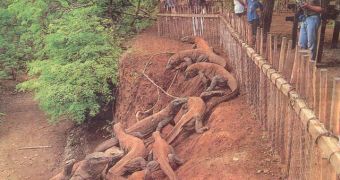It is by far the largest living lizard: the Komodo dragon (Varanus komodoensis) grows over 3 m (10 ft) in length, weighing over 154 pounds (70 kg). But even if the giant monitor lizard manages to kill animals as large as water buffaloes (and in the past it may have feasted on pygmy elephants), its bite is relatively weak. A new research published in the Journal of Anatomy explains it: it is about the razor-sharp teeth and the powerful neck muscles.
"The Komodo has a featherweight, space-frame skull and bites like a wimp, but a combination of very clever engineering and wickedly sharp teeth allow it to do serious damage," said co-author Stephen Wroe, a biologist at the University of New South Wales in Australia.
The team made a model of the dragon's head and throat with software usually employed to determine minute forces in vehicles.
"The Komodo dragon displays a unique hold-and-pull feeding technique. Its delicate skull differs greatly from most living terrestrial large prey specialists, but it's a precision instrument. The lizard nabs prey with 60 perilous teeth, although its bite is weak. To make up for the lack of biting power, strong throat muscles drag the meal through the razor-sharp jowls and into the stomach. The eating action removes dangerous stress from the fragile yet streamlined skull. This remarkable reduction in stress... is facilitated partly by the shape of the bones. Their arrangement is a key to success," said Wroe.
The Komodo dragon use to chop off large chunks of its prey and swallow them. The non-digestible parts are later regurgitated in a stenchy pellet of hair, bones and other remains. The Komodo dragon (who got its name from the Indonesian island of Komodo, its native area) is also famous for its ability to reproduce without sex (via parthenogenesis).
Monitor lizards appeared during the dinosaur era, 100 million years ago. They survived the dinosaur extinction and are known to inflict infectious bites. The Komodo dragon is still a dwarf compared with its relatives that inhabited Australia during the Tertiary and were up to 8 m (27 ft) long. Even so, the sea relatives of the monitor lizards dwarfed all monitor lizards ever: the mosasaurs were the largest marine reptiles ever, up to 17 m (57 ft) long, as much as a humpback whale.

 14 DAY TRIAL //
14 DAY TRIAL //